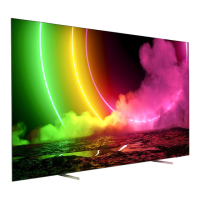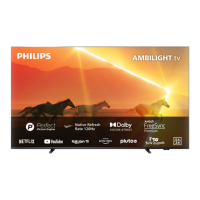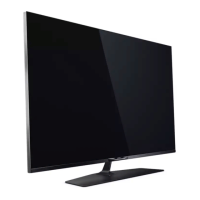Do you have a question about the Philips 55OLED909 and is the answer not in the manual?
Process to refresh the OLED screen to maintain picture quality over time.
Recommendations for preventing image retention and maintaining OLED display life.
Feature to reduce residual images by displaying a moving logo.
Overview of the TV's Home screen and its content discovery features.
Accessing TV settings, device controls, and notifications via the dashboard.
Difference between Google TV and Basic mode features.
Instructions on how to navigate and open items from the Home screen.
Importance of reading safety instructions before TV use.
Instructions for installing the TV stand or preparing for wall mounting.
Guidance on optimal TV placement for viewing experience and Ambilight.
Correct procedure for connecting the TV's power cable.
Explanation of buttons and special features of the remote control.
Methods for charging the TV remote control via USB or wireless.
Steps to pair the remote control with the TV using Bluetooth.
How to switch the TV on, reboot, and put it into standby mode.
Basic TV operations using the physical keys on the TV itself.
Guide to installing satellite channels, including Unicable systems.
Configuring country-specific settings for satellite channel installation.
Using a Conditional Access Module (CAM) for premium channels.
Setting up the TV to automatically update channels daily.
Manually initiating a scan for updated TV channels.
Procedure to reinstall all channels while keeping other settings.
How to copy installed channel lists to a USB drive and then to another TV.
Instructions for uploading a channel list to a new or existing TV.
Steps to install TV channels from various sources.
Managing and viewing different channel lists like All, Favorites, etc.
Filtering and sorting channels based on type, genre, or status.
How to lock specific channels to prevent viewing without a PIN.
Setting age ratings to restrict access to programs based on content suitability.
Setting preferred subtitle languages for digital broadcasts.
Selecting preferred audio languages for programs with multiple audio tracks.
How to create and name custom lists of favorite TV channels.
Adding consecutive channels or modifying existing favorite lists.
How to select specific pages within Teletext content.
Customizing Teletext display like freeze page, dual screen, and enlarge view.
Using interactive services like HbbTV for enhanced TV experiences.
Information about program listings and their availability.
Navigating and using the TV Guide for program information and tuning.
Using HDMI ARC/eARC for audio return and high-quality audio transmission.
Controlling connected HDMI CEC devices with the TV remote.
How to connect a Home Theatre System via HDMI ARC/eARC.
Using an optical cable for audio output to a Home Theatre System.
Using a Conditional Access Module (CAM) for premium channels.
Using the Philips Smart TV app for remote control and content streaming.
Connecting a Blu-ray player using HDMI and EasyLink.
Connecting headphones to the TV and adjusting volume.
Connecting game consoles via HDMI for optimal gaming experience.
Connecting and configuring a USB keyboard for TV input.
Viewing media files from USB flash drives or hard drives.
Connecting a digital camera to view photos directly on the TV.
Connecting a camcorder to the TV using an HDMI cable.
Connecting a subwoofer to enhance audio bass.
Steps for connecting the TV to a Wi-Fi network.
Steps for connecting the TV to a network router via Ethernet cable.
Creating a profile for children to access age-appropriate apps and content.
Selecting and switching to different connected input sources.
Streaming content from Apple devices and controlling the TV via HomeKit.
Adjusting various picture settings for optimal viewing quality.
Choosing preset picture styles optimized for different content types.
Automatically setting picture style based on detected film content.
Adjusting OLED contrast for picture quality and power saving.
Optimizing picture settings based on ambient light conditions.
Improving contrast and brightness for HDR effects and detail.
Optimizing HDR performance and tone mapping for different content.
Selecting motion modes for smoother video playback.
Reducing video noise and artefacts for clearer images.
Adjusting the picture aspect ratio to fit the screen without distortion.
Settings to protect the OLED screen from image sticking and pixel stress.
Selecting preset sound styles for different listening experiences.
Customizing sound preferences like speaker virtualizer and EQ.
Connecting wireless speakers for immersive surround sound.
Configuring TV sound output to TV speakers or connected audio systems.
Adjusting digital audio formats and delay for optimal sound.
How to enable or disable the Ambilight feature.
Selecting and customizing Ambilight effects and colors.
Activating Ambilight for ambient lighting when the TV is in standby.
Overview of TV apps, their functions, and installation from Google Play Store.
Downloading and installing apps, games, movies, and music.
Optimizing TV performance by stopping, clearing cache, or uninstalling apps.
Enabling features for deaf, hard of hearing, blind, or visually impaired users.
Updating the TV's software via Internet or USB for new features.
Applying eco settings to reduce power consumption and adjust picture.
Setting a timer for the TV to automatically switch off.
Pairing, connecting, and managing Bluetooth devices with the TV.
Viewing remote control status and updating its software.
Playing photos, music, and videos from a connected USB device.
Instructions for playing video files from USB, including playback controls.
Accessing game-specific settings and information during gameplay.
Utilizing tools within the Game Bar for enhanced gaming experience.
Overview of Alexa voice control capabilities on the TV.
Step-by-step guide to setting up Alexa voice control on the TV.
Details on energy efficiency, battery disposal, and product recycling.
Details on tuner bands, digital/analogue reception, and satellite inputs.
Running diagnostic tests to check TV condition and troubleshoot issues.
Diagnosing and fixing issues related to picture quality or sound output.
Essential safety guidelines to prevent electric shock, fire, injury, or damage.
Proper methods for cleaning and maintaining the TV screen.
Legal terms, warranty information, and pixel/backlight characteristics.
Trademark and software experience details for Google TV.
Information regarding HDMI terms, trade dress, and logos.
Information on accessories designed to work with Apple AirPlay.
Information on accessories designed to work with Apple HomeKit.
Information on NVIDIA G-SYNC technology for enhanced gaming.
Process to refresh the OLED screen to maintain picture quality over time.
Recommendations for preventing image retention and maintaining OLED display life.
Feature to reduce residual images by displaying a moving logo.
Overview of the TV's Home screen and its content discovery features.
Accessing TV settings, device controls, and notifications via the dashboard.
Difference between Google TV and Basic mode features.
Instructions on how to navigate and open items from the Home screen.
Importance of reading safety instructions before TV use.
Instructions for installing the TV stand or preparing for wall mounting.
Guidance on optimal TV placement for viewing experience and Ambilight.
Correct procedure for connecting the TV's power cable.
Explanation of buttons and special features of the remote control.
Methods for charging the TV remote control via USB or wireless.
Steps to pair the remote control with the TV using Bluetooth.
How to switch the TV on, reboot, and put it into standby mode.
Basic TV operations using the physical keys on the TV itself.
Guide to installing satellite channels, including Unicable systems.
Configuring country-specific settings for satellite channel installation.
Using a Conditional Access Module (CAM) for premium channels.
Setting up the TV to automatically update channels daily.
Manually initiating a scan for updated TV channels.
Procedure to reinstall all channels while keeping other settings.
How to copy installed channel lists to a USB drive and then to another TV.
Instructions for uploading a channel list to a new or existing TV.
Steps to install TV channels from various sources.
Managing and viewing different channel lists like All, Favorites, etc.
Filtering and sorting channels based on type, genre, or status.
How to lock specific channels to prevent viewing without a PIN.
Setting age ratings to restrict access to programs based on content suitability.
Setting preferred subtitle languages for digital broadcasts.
Selecting preferred audio languages for programs with multiple audio tracks.
How to create and name custom lists of favorite TV channels.
Adding consecutive channels or modifying existing favorite lists.
How to select specific pages within Teletext content.
Customizing Teletext display like freeze page, dual screen, and enlarge view.
Using interactive services like HbbTV for enhanced TV experiences.
Information about program listings and their availability.
Navigating and using the TV Guide for program information and tuning.
Using HDMI ARC/eARC for audio return and high-quality audio transmission.
Controlling connected HDMI CEC devices with the TV remote.
How to connect a Home Theatre System via HDMI ARC/eARC.
Using an optical cable for audio output to a Home Theatre System.
Using a Conditional Access Module (CAM) for premium channels.
Using the Philips Smart TV app for remote control and content streaming.
Connecting a Blu-ray player using HDMI and EasyLink.
Connecting headphones to the TV and adjusting volume.
Connecting game consoles via HDMI for optimal gaming experience.
Connecting and configuring a USB keyboard for TV input.
Viewing media files from USB flash drives or hard drives.
Connecting a digital camera to view photos directly on the TV.
Connecting a camcorder to the TV using an HDMI cable.
Connecting a subwoofer to enhance audio bass.
Steps for connecting the TV to a Wi-Fi network.
Steps for connecting the TV to a network router via Ethernet cable.
Creating a profile for children to access age-appropriate apps and content.
Selecting and switching to different connected input sources.
Streaming content from Apple devices and controlling the TV via HomeKit.
Adjusting various picture settings for optimal viewing quality.
Choosing preset picture styles optimized for different content types.
Automatically setting picture style based on detected film content.
Adjusting OLED contrast for picture quality and power saving.
Optimizing picture settings based on ambient light conditions.
Improving contrast and brightness for HDR effects and detail.
Optimizing HDR performance and tone mapping for different content.
Selecting motion modes for smoother video playback.
Reducing video noise and artefacts for clearer images.
Adjusting the picture aspect ratio to fit the screen without distortion.
Settings to protect the OLED screen from image sticking and pixel stress.
Selecting preset sound styles for different listening experiences.
Customizing sound preferences like speaker virtualizer and EQ.
Connecting wireless speakers for immersive surround sound.
Configuring TV sound output to TV speakers or connected audio systems.
Adjusting digital audio formats and delay for optimal sound.
How to enable or disable the Ambilight feature.
Selecting and customizing Ambilight effects and colors.
Activating Ambilight for ambient lighting when the TV is in standby.
Overview of TV apps, their functions, and installation from Google Play Store.
Downloading and installing apps, games, movies, and music.
Optimizing TV performance by stopping, clearing cache, or uninstalling apps.
Enabling features for deaf, hard of hearing, blind, or visually impaired users.
Updating the TV's software via Internet or USB for new features.
Applying eco settings to reduce power consumption and adjust picture.
Setting a timer for the TV to automatically switch off.
Pairing, connecting, and managing Bluetooth devices with the TV.
Viewing remote control status and updating its software.
Playing photos, music, and videos from a connected USB device.
Instructions for playing video files from USB, including playback controls.
Accessing game-specific settings and information during gameplay.
Utilizing tools within the Game Bar for enhanced gaming experience.
Overview of Alexa voice control capabilities on the TV.
Step-by-step guide to setting up Alexa voice control on the TV.
Details on energy efficiency, battery disposal, and product recycling.
Details on tuner bands, digital/analogue reception, and satellite inputs.
Running diagnostic tests to check TV condition and troubleshoot issues.
Diagnosing and fixing issues related to picture quality or sound output.
Essential safety guidelines to prevent electric shock, fire, injury, or damage.
Proper methods for cleaning and maintaining the TV screen.
Legal terms, warranty information, and pixel/backlight characteristics.
Trademark and software experience details for Google TV.
Information regarding HDMI terms, trade dress, and logos.
Information on accessories designed to work with Apple AirPlay.
Information on accessories designed to work with Apple HomeKit.
Information on NVIDIA G-SYNC technology for enhanced gaming.
| Screen Size | 55 inches |
|---|---|
| Display Technology | OLED |
| Smart TV | Yes |
| Operating System | Android TV |
| Refresh Rate | 120 Hz |
| HDMI Ports | 4 |
| USB Ports | 3 |
| Wi-Fi | Yes |
| Bluetooth | Yes |
| Ethernet | Yes |
| Dolby Atmos | Yes |
| Ambilight | Yes |
| Resolution | 4K UHD (3840 x 2160) |
| HDR Support | Dolby Vision |
| Voice Assistants | Google Assistant |











